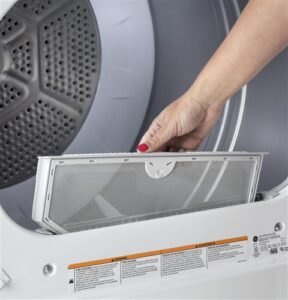
Here’s the deal: the F2 error code in GE dryers is like a tiny SOS from your machine. It’s a way for the dryer to communicate that there’s a problem in its world—typically with its temperature sensor or thermistor. Imagine if your dryer could talk; it might be saying, “Hey, something’s not letting me measure the temperature properly!” This issue could be due to a malfunction in the sensor itself, an issue with wiring, or even something blocking the sensor. It’s like trying to bake a cake without a working oven thermometer; you’re relying on guesswork instead of precision.
Understanding the F2 Error Code
The F2 error code acts as a guardian for your dryer, alerting you when something’s amiss. In technical terms, the thermistor is a small device inside your dryer that keeps tabs on the temperature. It ensures that things don’t get too hot or too cold. Think of the thermistor as the thermostat in your house—its job is to keep everything comfy and safe. When the thermistor has issues, it can’t do its job correctly. This is why your dryer flashes that F2 code on the screen.
When you see this error, it’s your dryer’s way of asking for a little TLC. It’s saying, “Help me check my temperature sensor!” Simple, right? Well, not always. Sometimes, the problem could be a loose wire or a break in the circuit. Other times, it could mean replacing the thermistor altogether. Just like when your car’s check engine light comes on, the F2 code is a signal that it’s time to investigate further.
For beginners, it’s important to remember that tackling this error doesn’t require a degree in engineering. However, it does involve a bit of detective work. You could start by unplugging the dryer and checking for any obvious signs of wear and tear. Also, examine the connections to ensure everything is snug and secure. But don’t worry, if this sounds a bit too technical, calling a professional appliance repair technician could be a smart move.
Diagnosing the Problem
Now that you know the F2 error code is all about temperature regulation, let’s explore how to diagnose the problem further. First, ensure that your dryer is unplugged before you start poking around. Safety is crucial, just like you wouldn’t stick your hand in the toaster when it’s plugged in. Start by locating the thermistor, which is typically near the outflow vent on your dryer drum. It’s that small, unassuming part that plays a big role in temperature control.
Once you’ve found the thermistor, inspect it carefully. Look for signs of damage like burns, corrosion, or loose wires. If you spot any of these, they might be the culprits behind the F2 code. Occasionally, the issue lies elsewhere, such as with the dryer’s control board. But don’t jump to conclusions just yet. It’s like assuming the book is bad just because you don’t like the cover.
Another component that could cause the F2 error is the heating element. If it’s not functioning properly, it can impact the temperature reading. This would be like trying to keep your coffee hot with a faulty kettle—ineffective and frustrating! Keep in mind that diagnosing these issues can sometimes require specialized tools, so if you’re not comfortable with hands-on repairs, a professional technician could be your lifeline.
Fixing the Error
Alright, so you’ve diagnosed the issue or, at least, narrowed it down, but what’s next? Fixing the F2 error can be simple or slightly complex, depending on the nature of the problem. If the thermistor is damaged, it may need replacing. Thankfully, replacement parts are often available online or at appliance stores, and they typically come with instructions. Think of it as switching out a faulty lightbulb—a bit time-consuming but definitely doable.
If the wiring seems to be the issue, ensuring all connections are secure can sometimes resolve the error. Again, make sure your dryer is unplugged before you get started. Check the connections carefully; a loose wire can be fixed with a simple reconnection. If the wiring seems too complicated—like untangling earphones that have a mind of their own—it may be time to call in a repair technician to ensure everything is in working order.
Lastly, if after all this, the error persists or if you suspect the control board is the problem, seeking professional assistance is wise. Much like how you wouldn’t want to perform surgery without the proper training, some dryer repairs are best left to the experts. They have the experience and tools necessary to safely and effectively fix the issue.
Preventing Future Errors
Now that you’ve tackled the F2 error head-on, let’s talk about keeping it from happening again. Regular maintenance is key. Think of it like going to the dentist for regular check-ups. You might not love it, but it prevents bigger issues down the line. Clean the dryer lint screen regularly and check the vents for any blockages. This helps maintain proper airflow and prevents overheating.
Additionally, it’s a good idea to gently wipe down the thermistor during these checks to remove any dust or debris that might hinder its function. Doing so can prolong its life and keep your dryer running smoothly. Imagine it like cleaning your glasses to ensure you always have a clear view—simple yet effective.
By staying vigilant and performing regular checks, you can keep the F2 error at bay and extend the lifespan of your dryer. Embrace these habits, and you’ll save yourself from future headaches and potential repair costs. After all, a little prevention goes a long way in keeping your dryer happy and efficient.